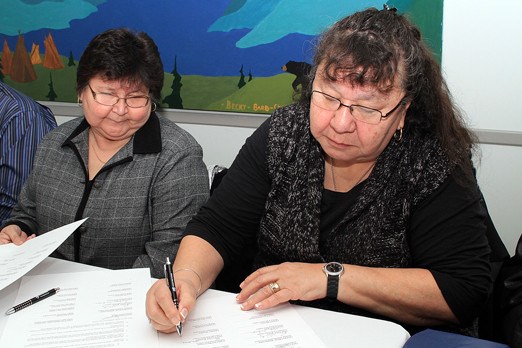Unless a ferrochrome processing facility is built in Northwestern Ontario, a group of Northern chiefs are threatening to bring the Ring of Fire to its knees.
“We’re not going to allow anyone to take any of these minerals and process them somewhere where our communities are not going to benefit and our people are not going to benefit,” said Matawa CEO David Paul Achneepineskum on Friday, after his chiefs signed a memorandum of understanding with the Lake Nipigon First Nations detailing a commitment to work together on mining and energy infrastructure issues.
“And I believe the whole Northwestern Ontario, including Mayor Keith Hobbs, is onside with us, including other municipalities. And that’s why we want to build the relationship with the municipalities as well.”
At least one community – and one of their own – is not onside just yet.
One group that was conspicuously absent was Eabametoong First Nation, located some 360 kilometres north of Thunder Bay.
A Matawa member, the community issued a release on Friday indicating its officials haven’t had a firsthand look at the MOU and only learned of its existence through a media advisory.
“The lands north of the Lake Nipigon territory fall within the joint traditional land use plan of Eabametoong and Mishkeegognamang First Nations,” the release states.
“Eababmootang First Nation questions the legitimacy of Matawa entering into an agreement where proper consultation has not occurred with the affected community and in particular where they haven’t been a party to the drafting of such agreements.”
Achneepineskum said he’s willing to sit down with any chief or community to discuss the MOU as it moves forward.
In addition to the FPF request, the two First Nations called on the province to put priority on a proposed electrical transmission line between Nipigon and Little Jackfish, a 100-megawatt project that would help supply power to the facility and explrore infrastructure and economic opportunities.
Achneepineskum, however, did not say what they plan to do to stop the Ring of Fire project should they not get their way.
In the past some First Nations communities have not allowed mining companies to explore their land, and last year two Marten Falls First Nation and Webequie First Nation took part in a Ring of Fire blockade.
“We haven’t taken it into consideration yet,” he said, reiterating a desire for a commitment to the region by the provincial government.
He went on to accuse both Queen’s Park and Ottawa of not meeting their duty toward First Nations. That’s got to be the first step, Achneepineskum said.
“They have to have some serious discussions and talk about benefits for our people,” he said. “The federal government and the Ontario government need to step up and meet their obligations, which were already defined by the Supreme Court of Canada on numerous occasions. They haven’t done that, and unless they do there are going to be issue in the actual mine and facility to go ahead.”
Minister of Northern Development, Mines and Forestry Michael Gravelle last week promised First Nations will be central to any discussions and stressed despite a recent setback, he remains committed to keeping the FPF in Northwestern Ontario.
While the Greenstone area is their first choice for the FPF, the company behind the project dealt a pair of blows to regional communities last week. Cliffs Natural Resources, a Cleveland-based company, first labeled Sudbury’s brownfield area as its best case, giving it a leg up on other competing communities, including Thunder Bay and Timmins.
Secondly. the company’s spokesman said unless Ontario gets its energy pricing levels under control, odds are no Ontario site will be chosen and the raw chromite will be shipped to Manitoba or Quebec for processing.
This is not acceptable said Chief Sonny Gagnon of Aroland First Nation.
“The chromite will be taken from the traditional territories of the First Nations people, so it only makes sense that we, the First Nations people, must directly benefit from the construction and the operation of the chromium processing facility,” Gagnon said. “Matawa First Nation strongly supports the request that the processing facility be located in the Greenstone area.”
Chief Pierre Pelletier of the Red Rock First Nation called the MOU an exciting moment, particularly that they’ll move forward in an attempt to secure the transmission line.
“We, as the chiefs of Lake Nipigon, wish to see this transmission line become a reality. It’s encouraging to see that the Matawa chiefs share our position,” said Pelletier in a release issued jointly by the two sides.
Pelletier and the other Lake Nipigon chiefs were delayed Friday and did not arrive in time for the ceremonial signing of the agreement.
Sign in or register
- Messages
- Post a Listing
- Your Listings
- Your Profile
- Your Subscriptions
- Your Likes
- Your Business
- Support Local News
- Payment History
Registered Users
Already have an account?
New Users
Create a free account.
